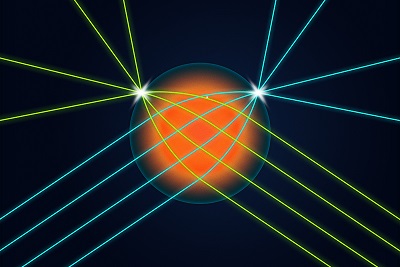A team of researchers from the University of Illinois has developed a spherical lens capable of allowing incoming light — from any direction — to be focused on the lens’s surface opposite the input direction into a very small spot. The lens is one of multiple microlens designs the researchers introduced, each of which are 3D printed and feature adjustable refractive indices.
Standard lenses have a single refractive index and, as a result, only a single access point for incoming light to travel through the lens. With the ability to precisely control both the shape of the lens in the fabrication process, and the properties of the internal refractive index, the researchers introduced two distinct ways to manipulate (bend) light inside a single lens.
University of Illinois researchers Paul Braun and Lynford Goddard led the study introducing the work. They report that the study is the first to successfully (with submicrometer precision) adjust the direction in which light bends as it travels through a single optical lens.
The design of the lenses has the potential to improve existing imaging and communications methods. In computing, the lens technology is poised to enhance the ability of computer chips and other optical systems to perform data-routing tasks.
The researchers used direct-laser writing, or multiphoton lithography, in the manufacture process; conventionally, the process involves focusing a femtosecond-pulsed laser into a photopolymer, leading to the solidification of the photopolymer at focal spot of the laser, Christian Ocier, lead author of the paper describing the study, told Photonics Media.
“Our process differs from traditional direct laser writing,” Ocier said, “in that we infiltrate the photopolymer into a porous scaffold and then solidify by directing the laser into the soaked porous scaffold. For the porous scaffold we chose porous silicon due to its optical transparency and the ability to allow the photopolymer to thoroughly wet its pores.”

Illinois researchers developed a spherical lens that allows light coming into the lens from any direction to be focused into a very small spot on the surface of the lens exactly opposite the input direction. The researchers report that this the first time such a lens has been made for visible light. Courtesy of University of Illinois News Bureau via Michael Vincent.
Specifically, the researchers, in their approach, programmed the printing file to focus the laser inside the porous silicon with which they worked, determining the optimal lasing intensities for their method and materials.
The team used a common, commercially available polymer, IP-Dip, capable of forming high-resolution structures, Ocier said. Other photoresins with differing optical properties, including those mixed with liquid crystals or tailored for specific biological applications, could be applied to the same process used by the Illinois researchers.
Though multiphoton lithographic microlenses currently exist, those lenses feature only a single refractive index. The polymers that the process typically solidifies forms optical structures up to 100× smaller than the size of a human hair.
“We addressed the refractive index limitations by printing inside of a nanoporous scaffolding support material,” Braun said. “The scaffold locks the printed micro-optics into place, allowing for the fabrication of a 3D system with suspended components.”
According to the researchers, the ability to achieve precise control of refractive indices likely stems from the process that occurs as the polymers solidify and set. Exposure conditions, paired with lasing intensity, dictates the amount of polymer that becomes entrapped within the pores.
Though the optical properties of the polymer remain unchanged, the overall refractive index of the material, as a function of laser exposure, is controlled, Braun said.

Illinois researchers, from left, Raman Kumar, Corey Richards, Alex Littlefield, Lynford Goddard, Haibo Gao, Paul Braun, Dajie Xie, Christian Ocier, and Andrea Perry. Courtesy of University of Illinois News Bureau via L. Brian Stauffer.
One of the three lenses the team fabricated in demonstration was a visible-light Luneburg lens — a lens that was previously impossible to fabricate given the need to create a refractive index gradient that strictly abides to a specific equation throughout a full 3D volume, Ocier said.
“As a Luneburg lens is designed to focus smaller wavelengths, the required resolution of the refractive index is increased.”
Prior to the current work, Ocier said, a team of researchers employed a multiphoton lithographic approach to make an optical frequency Luneburg lens, by creating a graded index sphere composed of cubic unit cells with different amounts of polymer versus air. Due to the resolution-imposed limitations of conventional multiphoton lithography, however, that Luneburg lens, featuring an operation wavelength of 6 µm, was unable to scale the focusing performance to achieve visible wavelength operation, Ocier said.
Beyond the manufacture of numerous optical components and imaging systems, including those that would advance the performance of and access to personal computing, the technology holds promise for additional forthcoming lens fabrication. The new technology enabled researchers to print compound lenses, including achromats — lenses that focus different colors of light to a common spot, Ocier said.
“Previously, achromats were made using two different photopolymers. The first step involves printing the first lens with a polymer with a specific refractive index value, then you develop away the unsolidified photopolymer. Afterward, a second photopolymer of a different refractive index would be added to define the second element … You would have to realign the laser precisely with the center of the first printed lens, then print the second lens on top of the first one.
“However, we can control the optical properties of a single photopolymer just by changing the laser power during the 3D printing. So we can skip a lot of extra steps, and the two lenses maintain good alignment. This could be very useful for things such as lens systems made with multiple elements for correcting color and for imaging.”
In the process of data transmission, Goddard said, the insertion of optical waveguides over conventional electronic connections supports increasing the speed to the transmission process; light at different wavelengths can send data in parallel. Because optical waveguides can only be made in a single plane, however, the number of points on a chip that can be connected is limited.
“By creating three-dimensional waveguides, we can dramatically improve data routing, transfer speed, and energy efficiency,” Goddard said.
Before commercializing can occur, the team at the University of Illinois must address the issue of “stitching” — printing one section of large 3D-printed structures at a time can cause structural errors.
“Imagine you try to draw a 10-ft-long line with a Sharpie,” Ocier said. “You cannot draw the entire line at once. You will have to draw the first half of the line, get up and walk 5 ft to the next location, and draw the second half of the line. There will be an error at the center of the line, because you cannot perfectly match both halves of the lines together.”
The new process is additionally serial in nature, Ocier said. “The challenge here is to find an approach that allows control over the 3D shape of an optical device, as well as its refractive index while writing multiple devices simultaneously.”
The U.S. Department of Energy, the University of Illinois, and the National Science Foundation supported the research, which was published in Light: Science & Applications (www.doi.org/10.1038/s41377-020-00431-3).